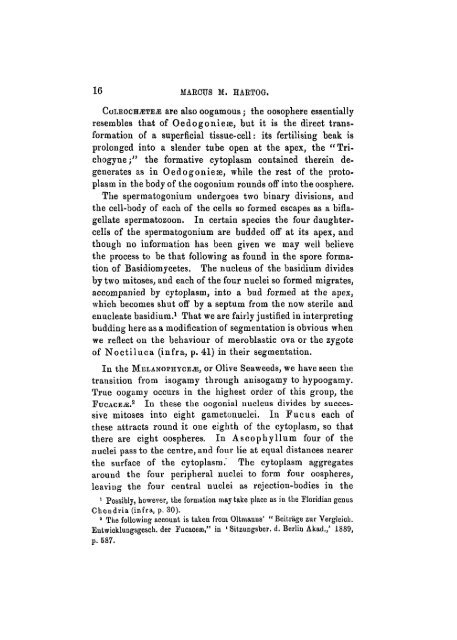Some Problems of Reproduction: a Comparative Study of ...
Some Problems of Reproduction: a Comparative Study of ...
Some Problems of Reproduction: a Comparative Study of ...
Create successful ePaper yourself
Turn your PDF publications into a flip-book with our unique Google optimized e-Paper software.
16 MAECUS M. HARTOG.<br />
COLEOCHJETE^: are also oogamous; the oosophere essentially<br />
resembles that <strong>of</strong> Oedogoniese, but it is the direct transformation<br />
<strong>of</strong> a superficial tissue-cell: its fertilising beak is<br />
prolonged into a slender tube open at the apex, the "Trichogyne;"<br />
the formative cytoplasm contained therein degenerates<br />
as in Oedogoniese, while the rest <strong>of</strong> the protoplasm<br />
in the body <strong>of</strong> the oogonium rounds <strong>of</strong>f into the oosphere.<br />
The spermatogonium undergoes two binary divisions, and<br />
the cell-body <strong>of</strong> each <strong>of</strong> the cells so formed escapes as a biflagellate<br />
spermatozoon. In certain species the four daughtercells<br />
<strong>of</strong> the spermatogonium are budded <strong>of</strong>f at its apex, and<br />
though no information has been given we may well believe<br />
the process to be that following as found in the spore formation<br />
<strong>of</strong> Basidiomycetes. The nucleus <strong>of</strong> the basidium divides<br />
by two mitoses, and each <strong>of</strong> the four nuclei so formed migrates,<br />
accompanied by cytoplasm, into a bud formed at the apex,<br />
which becomes shut <strong>of</strong>f by a septum from the now sterile and<br />
enucleate basidium. 1 That we are fairly justified in interpreting<br />
budding here as a modification <strong>of</strong> segmentation is obvious when<br />
we reflect on the behaviour <strong>of</strong> meroblastic ova or the zygote<br />
<strong>of</strong> Noctiluca (infra, p. 41) in their segmentation.<br />
In the MELANOPHYCEJE, or Olive Seaweeds, we have seen the<br />
transition from isogamy through anisogamy to hypoogamy.<br />
True oogamy occurs in the highest order <strong>of</strong> this group, the<br />
FUCACEJE. 2 In these the oogonial nucleus divides by successive<br />
mitoses into eight gametonuclei. In Fucus each <strong>of</strong><br />
these attracts round it one eighth <strong>of</strong> the cytoplasm, so that<br />
there are eight oospheres. In Ascophyllum four <strong>of</strong> the<br />
nuclei pass to the centre, and four lie at equal distances nearer<br />
the surface <strong>of</strong> the cytoplasm.' The cytoplasm aggregates<br />
around the four peripheral nuclei to form four oospheres,<br />
leaving the four central nuclei as rejection-bodies in the<br />
1<br />
Possibly, however, the formation may take place as in the Meridian genus<br />
Chondria (infra, p. 30).<br />
* The following account is taken from Oltmanns' " Beitrage zur Vergleich.<br />
Entwieklungsgesch. der Fucacese," in ' Sitzungsber. d. Berlin Akad.,' 1889,<br />
p. 587.

















